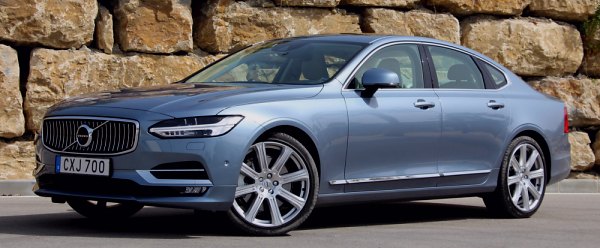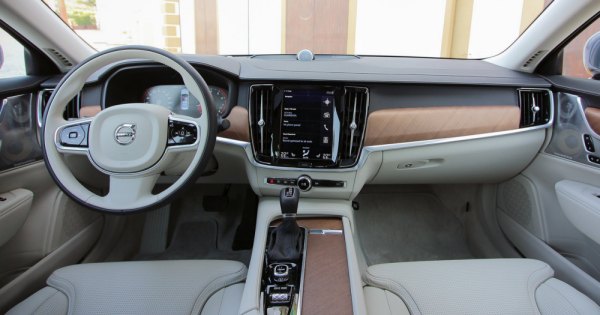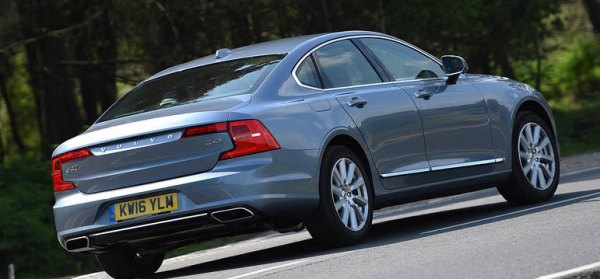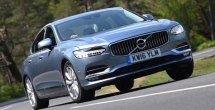|
|
|
| Published
on 28
Jun
2016 |
All rights reserved.
|
|

|
The last Volvo S80 was born
in 2006. We have been waiting for its successor too long. Many things
happened in the past 10 years. Under the management of Ford, Volvo
tried to emulate the sporty theme of its German rivals, but this
resulted in limited success. Its sales declined gradually and ran into
losses. 6 years ago, Ford gave up and sold it to Chinese car maker
Geely. With new investment and now Volvo's own people taking charge,
things improved step by step. Last year's second generation XC90 made a
breakthrough in the large SUV market with its elegant styling, fresh
interior and thoughtful engineering. It was regarded by many motoring
journalists as the best in class and the turning point for Volvo.
However, more important is that the large SUV introduces the new SPA
(Scalable Product Architecture) platform, which will form the basis of
next generation S60, XC60 and S80. Volvo is on the wave of revival.
The new S90 replaces S80 to be the company's flagship saloon, so it
competes with Mercedes E-class, BMW 5-Series, Audi A6, Jaguar XF, Lexus
GS etc. in the global executive car market. However, like the XC90 it
has found its own identity rather than following the formula set by
German. In terms of styling, the Swedish sedan is sleeker and cleaner
than most rivals. Its shape is nicely adapted from the Volvo Concept
Coupe (2013 Frankfurt) and Volvo Concept Estate (2014 Geneva). There is
none of the heavily twisted lines or sculpted surfaces so fashionable
in the industry, just subtle curves over planes. It follows the best
tradition of Scandinavian designs: form follows functions. The slim,
vertical waterfall grille works incredibly well at the nose. Not only
it avoids the XL-size approach usually taken by other executive cars,
the grille is also made more elegant by its concave surfacing. In
contrast, the headlights are quite fancy. Volvo calls its T-shape LED
element as Thor’s Hammer, though you might as well call it Bob the
Builder’s Hammer (I do think it looks more like the latter, see here). Similarly, the C-shape LED
taillights look not the best integrated with the body. Otherwise, the
S90’s exterior design is close to flawless. Most important, its unique
shape is refreshing.

|
The new car looks long and low. Will its coupe-like roof line hamper
rear headroom? Surprisingly, the cabin is actually very roomy for
six-footers both front and rear. The fifth passenger might find it
slightly less comfortable because of the wide transmission tunnel
(which is designed to house the battery for T8 plug-in hybrid model),
but the cabin feels light and airy. Moreover, thanks to relatively slim
pillars, all-round visibility is excellent – not quite as good as the
classic 240, 740 or 850, of course, but it is better than most rivals
these days. At the back, the Volvo offers a well-shaped luggage
compartment which can swallow 500 liters.
When you enter the cabin, you will notice its solidity from the door
thunk. The S90 feels built to high quality. Maybe a few switchgears are
not quite as expensive as Mercedes E-class, but the Volvo’s interior
design and build quality is classy in its own right. It tastefully uses
light-color wood, leather and aluminum to create a warm and natural
environment for you to relax. The simplicity of its design is made
possible by a great infotainment system with a 9-inch portrait
touchscreen, which is great for viewing navigation map. The broad front
chairs are as comfortable as you would expect from Volvo – and you know
how high Volvo is regarded in seat comfort. The vertical air vents
sandwiching the touchscreen are more effective than the circular ones
used by rivals. The stainless steel speaker grille at the door panel
and the alloy door pull look expensive, as are the jewel-effect engine
start button and drive mode selector on transmission tunnel. This is
the best finished interior of the class.

|
Sitting on the SPA platform, the S90 should be modern. As expected, its
monocoque chassis employs high percentage of high-strength steel to cut
weight while increasing rigidity. Some of the front chassis parts, such
as the bumper beam, suspension towers and tower brace, are made of cast
or extruded aluminum. It is not as aluminum-intensive as its German or
British rivals, and this is reflected on scale, but this is less
relevant as the Volvo does not pretend to be sporty. Like XC90, the car
employs classy double-wishbones front suspension. At the rear, it uses
integral-link arrangement and an unusual transverse composite leaf
spring (like Corvette) which has been proved effective on the XC90.
Optional suspension adds adaptive air springs at the rear axle and
adaptive dampers all round.
Most of the S90 sold must be front-wheel drive, but Volvo also offers
the XC90's AWD system with Haldex multi-plate clutch. The range of
engines and transmissions are also shared with the large SUV. All
engines come from the in-house-developed Drive-E 2-liter four-cylinder
family. The petrol models include 254 hp T5 (2.0 Turbo) and 320 hp T6
(2.0 turbo + supercharger), while diesel range consists of 190 hp D4
and 235 hp D5 (both 2.0 sequential twin-turbo). To reduce turbo lag,
the higher power diesel engine employs a VTG turbine as well as a new
anti-lag technology called PowerPulse, which uses compressed air to
spool up the turbine quickly (compressed air is stored at a 2-liter
high-pressure tank mounted beside the engine and remained charged up by
an electric pump). At the top, the T8 plug-in hybrid flagship combines
the T6 engine and a rear-mounted electric motor for 408 hp total. It
does performance in an environmental-friendly way, which is a strong
selling point against the German. All engines mate with an Aisin
8-speed automatic transmission.

|
Safety features are another strength of the large Volvo. Its Pilot
Assist is a semi-autonomous driving system that can read lane markings
and keep the car on road at speed up to 130 km/h (81 mph). However,
unlike Mercedes E-class its approach is more to enhance safety rather
than doing the driving for you, so it won't change lane automatically
on a press of turn-signal button, or turn a corner automatically. On
the plus side, its collision avoidance system now detects not only
pedestrians but also large animals like elks and cows. By upgrading the
collision avoidance system, Volvo shows not only social responsibility
but also wildlife responsibility. Such philosophy is so likeable!
So how does the large Volvo drive on the road? Pretty good, if not
exactly first class. You won’t expect the Volvo to be as sporty to
drive as a Jaguar or BMW, and this is still the case on the S90. It
isn’t as agile or as stable in corner, just as its FF mechanical layout
suggested. The steering is direct and heavy enough to inspire some
confidence, but there is not much feel, and the self-centering is too
strong to feel natural. Even with AWD installed, the S90’s handling is
biased towards safe understeer thus it won’t encourage you to abuse its
chassis. However, its handling is not clumsy either. Far from it
actually. You can drive the car quite quickly on mountain roads thanks
to its absorbent suspension and predictable handling. Its suspension is
dialed back from the rather hardcore setting of S60 and torwards the
comfort side more akin to Volvo. This has to be a clever move, because
comfort had always been the core value of Volvo until the Ford-era.
With softer suspension, the S90 inevitably rolls and pitches more in
corner by the usual norm of German cars. However, it rides very well,
floats over bumps and road imperfections, especially with air
suspension. Big or shape-edge bumps on highway can still catch it out
though (a common weakness of air suspensions), but in general the S90
is one of the most comfortable cars of the class for cruising. This is
also helped by its good directional stability and little wind, tire or
engine noise.
 |
As the S90 carries more weight than most rivals, and it is served with
only 4-cylinder engines, it is not particularly quick. Nevertheless,
all its engines provide good enough performance, including the least
powerful D4. The Drive-E diesel engine is still too loud at high rev,
but with nearly 300 pound-foot of torque you rarely need to work it
hard unless in a hurry. At lower revs, it is satisfyingly hushed and
smooth. D5 engine has a similar manner but is both punchier and more
responsive, thanks to PowerPulse technology. Comparatively, the T6
petrol is more refined, but it doesn’t feel as powerful as its 320-hp
rating suggested. BMW’s 3-liter straight-six turbo feels easily
stronger and smoother. Twin-charger is a good idea, but it is no
replacement for capacity and cylinders. It also needs to be worked
harder than the D5 to extract the same performance in real-world
driving. The electric assistance in T8 might help, but then the car
weighs 2 tons and costs a lot more to purchase. As predicted, gearshift
of the Aisin 8-speed automatic is more about smoothness than response,
no match with ZF auto.
The average powertrains and handling means the new S90 is not good
enough to top the class, but its handsome looks, excellent cabin and
high level of comfort still put it at a strong position. Not exactly a
position to challenge the German, because the Swedish car is now truly
different enough to avoid direct comparison. Who says there is only one
way to succeed?
|
Verdict:     |
|
|
|
|
|
|
|
|
|
|
S90 D4
|
2016
|
| Front-engined,
FWD |
| Steel monocoque |
| Mainly steel |
| 4963 / 1879 / 1443 mm |
| 2941 mm |
Inline-4 diesel
|
| 1969 cc |
DOHC 16 valves
|
Sequential twin-turbo
|
| CDI |
190 hp / 4250 rpm
|
295 lbft / 1750-2500 rpm
|
8-speed automatic
|
F: double-wishbone
R: multi-link
|
-
|
| 225/55R17 |
1733 kg
|
| 143 mph (c) |
7.7 (c) / 8.2*
|
| 22.1* |
|
S90 T5
|
2016
|
| Front-engined,
FWD |
| Steel monocoque |
| Mainly steel |
| 4963 / 1879 / 1443 mm |
| 2941 mm |
Inline-4
|
| 1969 cc |
DOHC 16 valves, DVVT
|
Turbo
|
| DI |
254 hp / 5500 rpm
|
258 lbft / 1500-4800 rpm
|
8-speed automatic
|
F: double-wishbone
R: multi-link
|
| Adaptive air spring + damping |
| 245/45R18 |
1726 kg
|
| 143 mph (c) |
6.5 (c) / 6.3**
|
| 15.7** |
|
S90 D5 AWD
|
2016
|
| Front-engined,
4WD |
| Steel monocoque |
| Mainly steel |
| 4963 / 1879 / 1443 mm |
| 2941 mm |
Inline-4 diesel
|
| 1969 cc |
DOHC 16 valves
|
Sequential twin-turbo, VTG
|
CDI, PowerPulse
|
235 hp / 4000 rpm
|
354 lbft / 1750-2250 rpm
|
8-speed automatic
|
F: double-wishbone
R: multi-link
|
| Adaptive air spring + damping |
| 245/45R18 |
1817 kg
|
| 149 mph (c) |
6.6 (c)
|
| - |
|
|
|
|
|
Performance
tested by: *Autocar, **C&D
|
|
|
|
|
|
|
S90 T6 AWD
|
2016
|
| Front-engined,
4WD |
| Steel monocoque |
| Mainly steel |
| 4963 / 1879 / 1443 mm |
| 2941 mm |
Inline-4
|
| 1969 cc |
DOHC 16 valves, DVVT
|
Turbo + supercharger
|
| DI |
320 hp / 5700 rpm
|
295 lbft / 2200-5400 rpm
|
8-speed automatic
|
F: double-wishbone
R: multi-link
|
Adaptive air spring + damping
|
| 245/45R18 |
1817 kg
|
| 155 mph (limited) |
5.6 (c) / 5.6* / 5.6**
|
13.9* / 14.5**
|
|
S90 T8 Twin Engine
|
2016
|
| Front-engined,
e-4WD |
| Steel monocoque |
| Mainly steel |
| 4963 / 1879 / 1443 mm |
| 2941 mm |
Inline-4 + electric motor
|
| 1969 cc |
DOHC 16 valves, DVVT
|
Turbo + supercharger
|
| DI |
320 + 88 = 408 hp
|
295 + 177 = 472 lbft
|
8-speed automatic
|
F: double-wishbone
R: multi-link
|
Adaptive air spring + damping
|
| 245/40WR20 |
2002 kg
|
| 155 mph (limited) |
5.0 (c) / 4.5*
|
| 12.3* |
|
|
|
|
|
|
Performance
tested by: *C&D, **MT
|
|
|
|
|
|
|
|
|
|
|
General models

|
|
|
Copyright©
1997-2016
by Mark Wan @ AutoZine
|
|